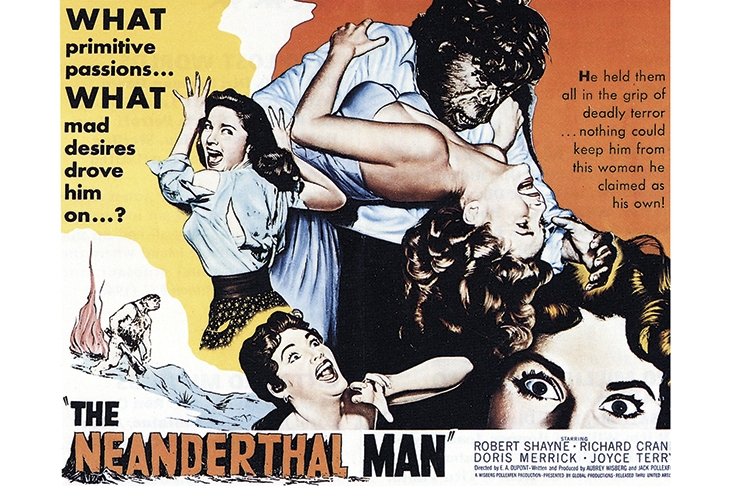My brother recently decided to get a DNA test. He discovered that our family were all descended from a mix of the usual British suspects — a bit of Viking, Anglo-Saxon and Celt — and were predisposed to standard diseases and health risks. But there was one surprise. My siblings and I had double the normal amount of Neanderthal in our genes.
Reactions were mixed. My girlfriend declared she had suspected something of the sort for some time. My mother announced that it must come from my father’s side of the family. And it took us a while to digest.
It’s now well established that all humans have a small quantity of Neanderthal genes: the result of contact that occurred largely in the Middle East and Europe when Homo sapiens arrived more than 40,000 years ago to find Neanderthals already there. And seeing as that’s a fair while, there must been a great deal of what scientists genteelly call ‘interbreeding’ for even some evidence of it to survive today. The amount my siblings and I had, though, was way, way above average. It was impossible to ignore.
But then came help. I stumbled on an attractive scholarly thesis which proposed that the Neanderthal element within Homo sapiens was the part that added interest —that was, so to speak, the little spike of mustard in the mix. It can give a creative spark and has allowed us as a species to think outside the box. According to this thesis, the Neanderthal is the Mac component, with the design flair, while standard Homo sapiens is the boring old PC. Neanderthals were wilder, improvisational, free — and, the palaeontologists have shown, had bigger brains. The more Neanderthal you have within you, the more likely you are to break loose.
To say this came as a pleasurable hypothesis would be an understatement. Not only could I now frame myself as a proud Neanderthal, but as a middle-aged, middle-class white man living in the south of England, it could give me something I badly needed — identity politics.
Because Neanderthals have been patronised and demonised for too long. Some consciousness-raising is badly needed. Even President Joe Biden, like so many of the woke, turned out to be just as prejudiced as those they seek to condemn when he made his cruel gibe that not wearing a mask was ‘Neanderthal thinking’.
Really? I was offended by his remark. Quite apart from the fact that he may have just dissed his entire political constituency, doesn’t he realise that back in the day, Neanderthals would probably have made their own masks long before Homo sapiens even thought of it? Remarkable archaeological discoveries over the past few years have shown that contrary to prejudice and expectations, Neanderthals were usually ahead of the curve: they were creating art, building boats to sail across waterways and making tools long before their rivals.
Some rebranding needs to be done. The word Neanderthal — from the German valley where the first remains were found — carries a pejorative overtone of a lunk-jawed caveman looking at a fire and not knowing how to light it. We need something new.
Perhaps ‘First Man’ would be good. I could imagine meeting somebody at a party and asking them politely how much ‘First Man’ they had in their make-up. Or of course ‘First Woman’, depending on how they gender-identified. I’ve noticed, though, that women tend to think of being Neanderthal as a purely male preserve, even when, like my sisters, they’ve got just as much of it in their DNA as I have.
The discovery that we contain elements of a whole other hominid species may also mark a paradigm shift in our understanding of ourselves; just as when we realised that the sun did not revolve around the Earth, or that we were as much animal as any of our Darwinian relations. I reckon it’s quite a liberating thought.
In his bestselling book Sapiens, Yuval Noah Harari makes the point that the worst thing we ever did as a species was to settle down and become agriculturists, with a dependence on a monotonous diet and a far more punishing work schedule than when we were hunter-gatherers. Perhaps it’s time we embraced our inner Neanderthal again. Get us out and about more. Loosen us up. Although obviously it helps if you have more of it in your genes to start with.






Comments